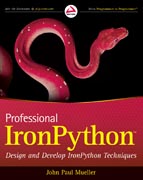
Part I: Introducing IronPython This short part is designed to get the reader started using IronPython. It answers basic installation and usage questions, how to get help, and what makes IronPython different from other languages. The reader also discovers how to use familiar tools such as Visual Studio to work with IronPython and creates a very simple IronPython example. Most importantly, the reader becomes familiar with the IronPython environment and discovers how to use it. Part II: Using the IronPython Language In this part, the reader learns the IronPython language. It assumes that the reader has worked with other programming languages and knows about basic programming constructs such as loops. This part is designed to get experienced developers up and running with IronPython quite quickly. Part III: Working with IronPython Once the reader understand IronPython and its environment, its time to explore IronPython in actual use. IronPython can make use of the Python standard library and operate stand-alone or in concert with the .NET Framework, so this part explores both environments. In addition, the reader can use IronPython to create either desktop or Web-based applications, so this part shows both. Most readers will want to know how to interact with existing technologies such as the Component ObjectModel (COM) so there are areas that explore these needs as well. One interesting feature of this section is showing how to use IronPython to perform administration tasks. Microsoft is emphasizing the command line more in current products such as IIS and Exchange Server. In addition, Windows Server 2008 Server Core is nothing more than a command line environment, so this chapter plays tothe current direction in Microsoft technology and gives this book a distinct advantage over the competition. Part IV: Advanced IronPython Topics The readerof this book is advanced and wants advanced topics, so the bulk of the book concerns itself with topics that a knowledgeable reader will want. This sectionanswers a wealth of interoperability questions, such as using IronPython fromother .NET languages and working with external resources such as Web services. The reader will also discover techniques for extending IronPython and makingit a more robust language. Finally, this part discusses two interesting topics: using IronPython to automate application testing and executing IronPython using Mono. This last topic is something you wont find anywhere else and its doubtful anyone else will tackle it. This last chapter effectively extends IronPython into environments the reader may not have considered such as Windows Server 2008 Server Core (which lacks support for the .NET Framework) and Linux.John Paul Mueller is the owner of his consulting firm, DataCon Services. As aconsultant, he has written code for everything from database management systems (DBMS) to low level hardware access code. His use of languages has includedassembler, C++, LISP, C#, Visual Basic.NET, F#, Java, and PHP. Over the last 23 years, he has produced 80 books and over 300 articles, many of which provide developer support. The topics range from networking to artificial intelligence and from database management to heads-down programming. His current books include three on Web services (Google, Amazon, and eBay), two on Web development, one on working with the Win32 API from a .NET application, and a programmers guide that discusses the new Office Fluent User Interface (RibbonX). Hes also contributed articles to magazines such as CIO.com, DevSource, InformIT, Informant, DevX, SQL Server Professional, Visual C++ Developer, Hard Core Visual Basic, asp.netPRO, Software Test and Performance, and Visual Basic Developer.
- ISBN: 978-0-470-54859-2
- Editorial: John Wiley & Sons
- Encuadernacion: Rústica
- Páginas: 480
- Fecha Publicación: 16/04/2010
- Nº Volúmenes: 1
- Idioma: Inglés
